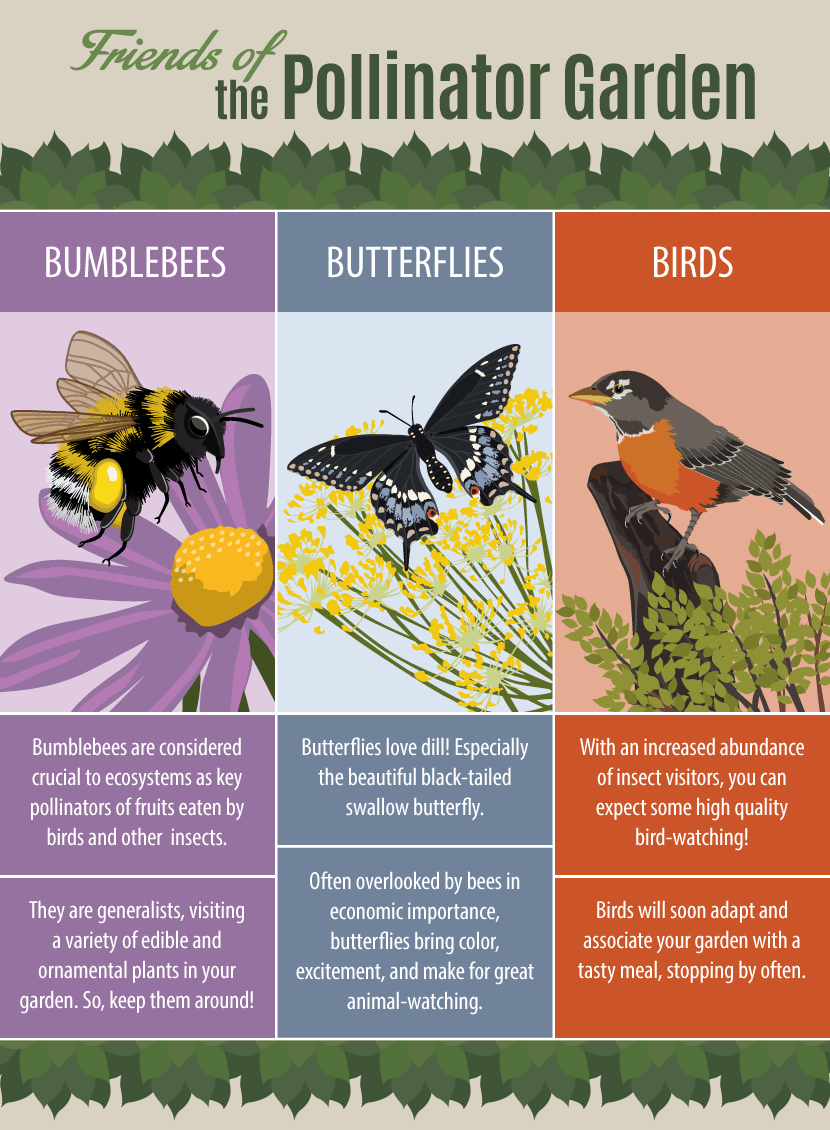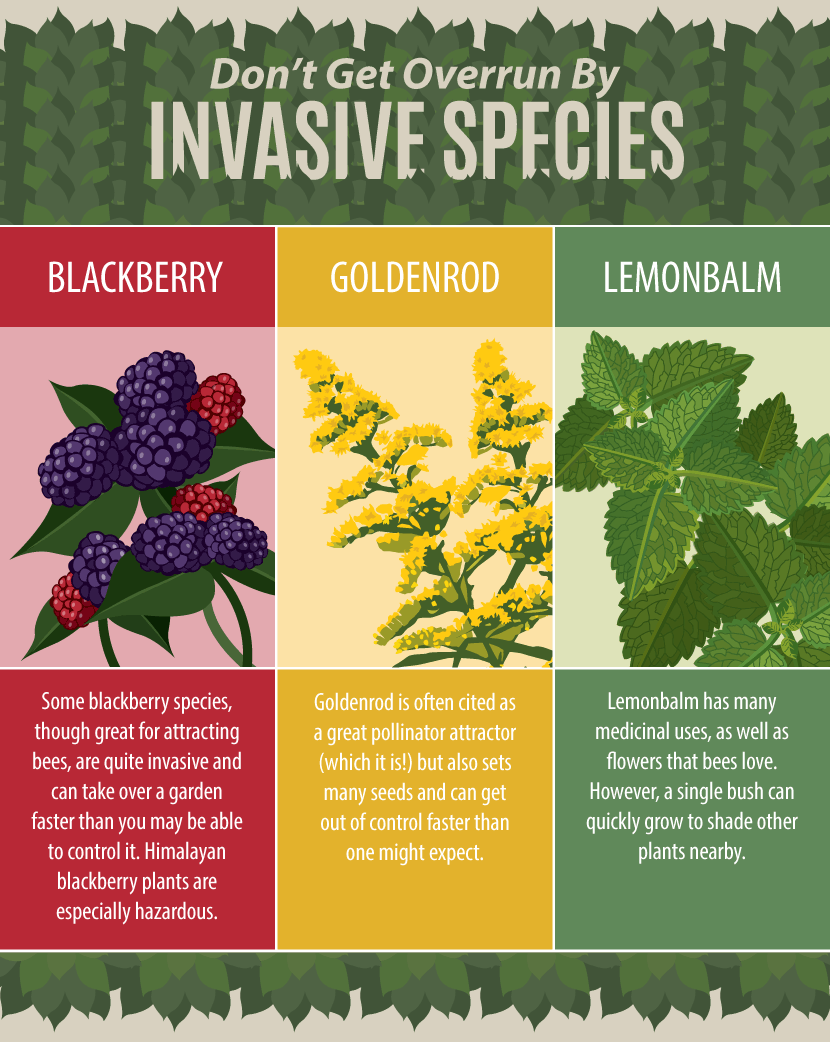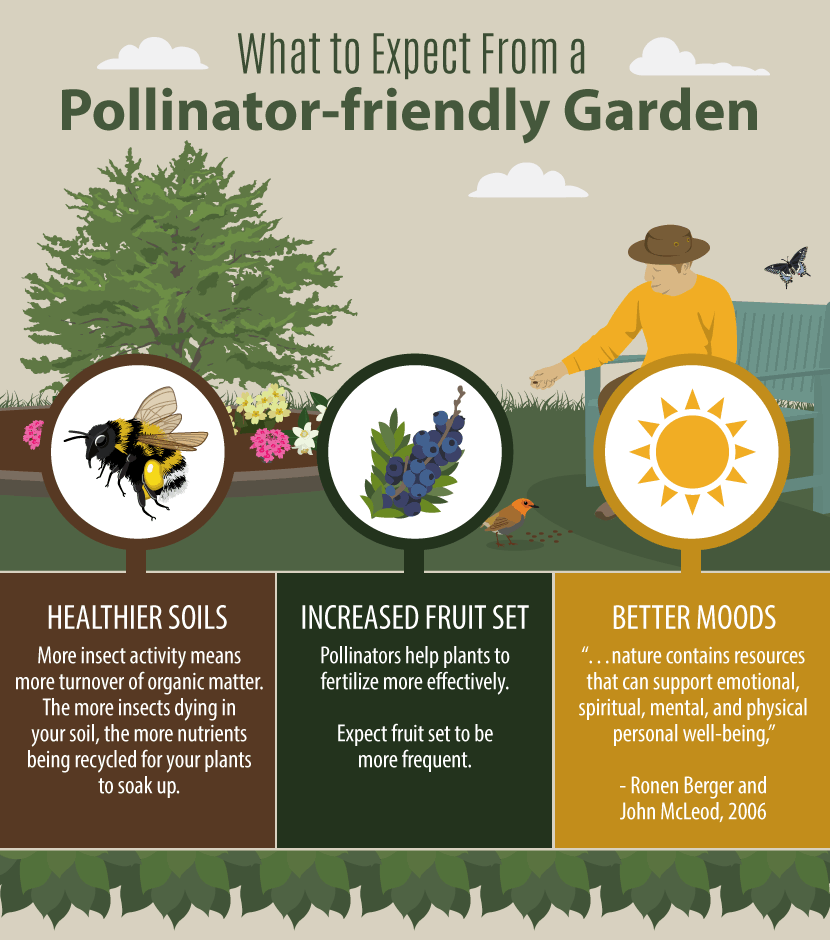Creating a Pollinator-Friendly Garden
Declines in pollinator health have taken headlines by storm in recent years. But what are pollinators, why are they so important, and what can a gardener do to promote pollinator visits?
Pollinators are any animal that effectively transfers pollen from one individual plant to another (typically within the same plant species). The most well-known pollinators are bees, but they also include moths, butterflies, birds, beetles, and bats.
Pollination is a wonder of mutualism. The plant provides food in the form of pollen or nectar – advertised by showy flowers – and in return, pollinators help spread the genetic material of the plant (pollen), ensuring vigorous, diverse plant communities.
Perhaps most importantly to us, pollination stimulates the onset of fruit production in many plants. Without pollination, we wouldn’t have blueberries, cashews, broccoli, peppers, beans, watermelons, or even coffee!

With the advent of modern agriculture, planting just one type of crop over large areas of land has become the most widespread method of farming. Think of expansive corn, wheat, or soybean fields. While economically favorable, this farming practice can lead to a loss of plant and pollinator diversity.
To ensure the pollination of crops we depend on, bees are often transported across the continent to be unloaded during flowering periods. Nearly three quarters of the food you eat needed pollination to be produced!
Some Great Options
So how can we promote pollinators locally to ensure fruit grows in your own garden? By planting some of pollinators’ favorite plants, of course! These plants are not only pollinator friendly, but they can be aesthetically desirable, nutrient fixing, and edible. So, let’s go over some of the most effective pollinator-attracting plants for a healthy, biodiverse garden.
Crocus (Crocus spp.): These are early bloomers and are often the first flowers to emerge from the ground following winter. About two months before the fall frost sets in, plant bulbs three inches deep into well-draining soil. Because crocuses are ornamental, planting them in your lawn or along the edge of a garden works best. If your autumn months are dry, be sure to water the bulbs occasionally. Crocuses can be found in reds, yellows, pinks, and blues, so they make great decorations and bees love them! Because they are early bloomers, you can offer your spring pollinators a meal as the newest generation emerges from the nest.
Foxglove (Digitalis spp.): This is another early bloomer that can be planted for the same reason as crocuses. Their tall columns of beautiful pink, purple, and white flowers are irresistible to bees. Sow your seeds in pots in early summer and keep the soil moist.

In the early autumn, transfer your seedlings to your garden to allow them enough time to adapt to their new home before the winter. Foxgloves need a spot with lots of sun and well-draining soil. In the coming spring, you will enjoy these tall, lovely flowers, which are often bustling with pollinator activity! Though foxglove is short-lived, it sets many seeds, and gardeners generally end up having to remove extra plants rather than re-seeding.
Lavender (Lavandula angustifolia): This is a beautiful plant that flowers purple in the early to mid-summer and buzzes with pollinator activity. It has a lovely aroma, and it can be harvested to hang in one’s home or to use in handcrafts, such as soaps and salves.
Lavender seeds are best sown in the late autumn in a seed tray to keep them from freezing over the winter. They can take up to three weeks to germinate, so be patient! Seedlings will grow over the winter and spring, at which point they can be put into pots. Keep the plants in sunny areas of your garden with well-drained, healthy soil. If you decide to keep them around for a few years, prune them every spring to encourage healthy new growth.
Dill (Anethum graveolens): So far, we’ve done a great job at attracting bees, but how about some butterflies? Perhaps one of the most widely used herbs for attracting these delicate, winged pollinators is dill. Dill is known to be an excellent food source for both the caterpillar and the butterfly, so it makes a choice plant to promote butterfly activity in your garden – not to mention all the dill you can eat! Like lavender, dill is an early summer plant, so wait for the last frost of the spring before planting. Dill is an annual plant, meaning it will only last one season. Luckily, it also sheds lots of seeds before dying, so you can usually rely on having more in the following years!
Pumpkin (Cucurbita pepo): What if you could attract pollinators to your garden AND harvest food from the same plant? There are dozens of such plants, including pumpkin. This plant is edible (pies, soups, and seeds) and is a late-flowering plant that will keep pollinators in your garden from late summer to early fall.
Pumpkins usually require warm weather when seeding. Start seeds in April or May to ensure that you have some young seedlings by the time the summer nights are warm enough (about 60°F) to transplant. Transfer young seedlings into well-fertilized, organic matter-rich soil for pumpkins that will be ready just in time for Halloween!
What to expect from a pollinator-friendly garden
Gardens are a great way to stay connected with nature. Ronen Berger and John McLeod’s 2006 study showed that incorporating nature into therapy methods was beneficial to patients. They suggested that the gap between human communities and nature has been widening for generations but that we are becoming more aware that we need to reconnect with nature.

Be sure to consider the long-term effects of attracting pollinators to one’s property. For those living in an urban environment, these new visitors can be surprising or even startling. Fear not! Though bees do sting, they only do so when threatened or disturbed.
Attracting pollinators to your garden is a form of re-wilding, or returning an ecosystem to one that resembles its pre-human state. This can mean more bees, butterflies, and insects as well as birds (that feed on bugs) and other small animals. To some, this is a huge part of the appeal of a pollinator-friendly garden: a natural habitat in your own backyard!
Embed the article on your site

